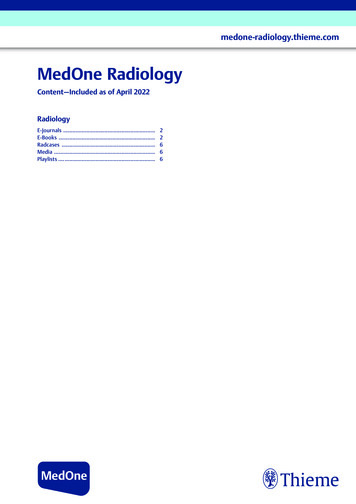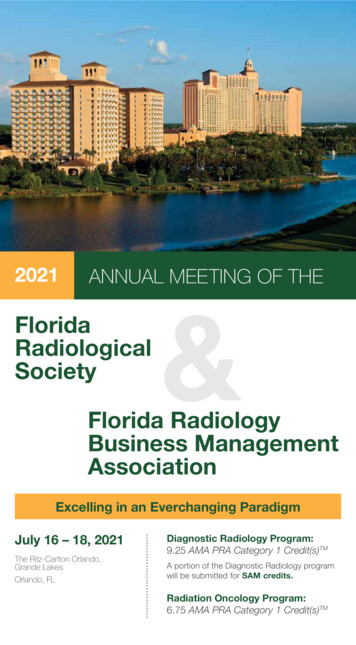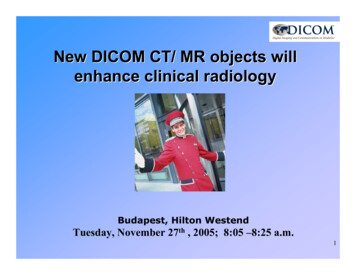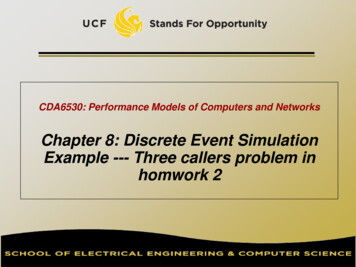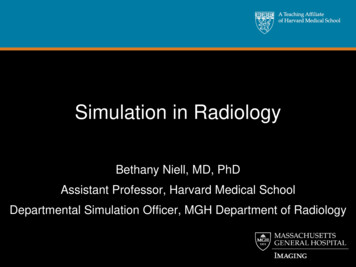
Transcription
Simulation in RadiologyBethany Niell, MD, PhDAssistant Professor, Harvard Medical SchoolDepartmental Simulation Officer, MGH Department of Radiology
I have no conflicts of interest todisclose.
Agenda Outline the basic components of a successful medicalsimulation program Describe the need for medical simulation in radiology Provide an overview of the MGH Department of Radiologycontrast and emergency management (CEM) simulationprogram Review data and lessons learned from our initial experience Introduce IR procedural simulators Highlight opportunities for future simulation initiatives inradiology
Levels of Simulation Low techSlide courtesy of Emily Hayden, M.D.
Levels of Simulation Screen-basedSlide courtesy of Emily Hayden, M.D.
Levels of Simulation Complex Task TrainerSlide courtesy of Emily Hayden, M.D.
Levels of Simulation Simulated (Standardized) PatientsSlide courtesy of Emily Hayden, M.D.
Levels of Simulation High-fidelity Patient SimulatorsSlide courtesy of Emily Hayden, M.D.
Levels of Simulation Virtual RealitySlide courtesy of Emily Hayden, M.D.
Medical simulation applicationsSabir et al. JACR 2014; 11:512 and Dawson JVIR 2006;17:205
Why do simulation? Improved knowledge retention1– Reading/Hearing 6 week retention rate: 10-20%– Simulation 6 week retention rate: 80% Knowledge retention increases when thelearning experience is similar to the clinicalscenario 21 EdgarD. Audiovisual methods in teaching. Hinsdale, IL: Dryden Press 19542 HallinanJT. Why we make mistakes. New York: Broadway Books 2009
Necessary components of simulation* Course logistics/scheduling Simulation case development Assessment instruments Course evaluation Debriefing after simulation exercise– Reflecting on one’s own practice is critical to experientiallearning– Allow participants to explain, analyze, and synthesizeinformation to improve performance– Debriefing with good judgment developed and taught by theInstitute for Medical Simulation in a one week course 1– Simulation without debriefing increases confidence but not skill*Adapted from the Institute for Medical Simulation Instructor Training Course Cambridge, MA1 Rudolphet al. Anesthesiology Clinics 2007;25:361 and 2 Marteau et al. BMJ 1990;300:8492
Medical simulation has becomeincreasingly routine in Anesthesiology andCritical Care, Obstetrics/Gynecology,Surgery, Emergency Medicine, andPediatrics.How many of you have been involved in medicalsimulation exercises within radiology?
Agenda Outline the basic components of a successful medicalsimulation program Describe the need for medical simulation in radiology Provide an overview of the MGH Department of Radiologycontrast and emergency management (CEM) simulationprogram Review data and lessons learned from our initial experience Introduce IR procedural simulators Highlight opportunities for future simulation initiatives inradiology
Simulation in Radiology PACS simulators with immediate feedback on cases totrainees Screen-based virtual reality simulator for assessment oftrainee preparation prior to overnight call Simulation-based training for ultrasound-guided procedures Endovascular procedure simulators – novice and expertlevel Mannequin-based simulation for contrast reactions andemergency management (CEM) preparedness
Adverse reactions to contrast media Iodinated contrast– Less common with newer agents– Incidence ranges from 0.2-0.7% Gadolinium– Lower frequency than iodinated contrast– Incidence ranges from 0.02%-2.4% Treatment– 41% of patients received treatment– 1% of patients receiving treatment developed complications– 8/15 patients treated with epinephrine received the incorrectdosage of epinephrine (3 with cardiac sequelae)Wang et al. AJR 2008; 191:409-415 and ACR Manual on Contrast Media 2013
CEM education before simulation Annual live lecture to trainee physicians during orientation Annual live lecture to attending physicians during a riskmanagement conference Transition to online modules in 2009-2010 “On the job” experience
Effectiveness of CEM didactic educationPre ModuleHow comfortableComfortabledo you feel treating n (%)a patient with ananaphylactoidreaction tocontrast media?Post ModuleNotcomfortablen (%)Comfortablen (%)Notcomfortablen (%)Physician*144 (59%)100 (41%)209 (86%)35 (14%)Nurse*51 (73%)19 (27%)65 (93%)5 (7%)Technologist*98 (54%)84 (46%)134 (74%)48 (26%)Total (n 522) *303 (58%)219 (42%)425 (81%)97 (19%)Niell et al. JACR 2014;11:185
Contrast and emergency managementsimulation in Radiology To date, several small simulation programs in radiologydepartments have focused on resident education Residents who underwent simulation reported improvedperformance compared to didactic instruction alone Simulation following didactic instruction improvedperformance compared to simulation alone in radiologyresidents
What about simulation for technologists? Simulations with teams of radiologyresidents and technologistsdemonstrated similar knowledgeimprovement for both role groups andemphasized importance ofcommunication
Communication and Teamwork 43% of safety events involve poor communication Teamwork and communication failures are thestrongest predictor of surgical errorsGawande et al. Surgery 2003;133:614 and Wiegmann et al. Surgery 2007;142:658Slide from Gloria Salazar, M.D.
Interventional Radiology Suites Prone to the same types of errors, including communicationerrors, associated with traditional operating rooms MGH Department of Radiology– 17 interventional suites– Approximately 18,000 interventional procedures annually– 2,000 of which require anesthesiology support Procedure complications account for approximately 1/3 ofmalpractice allegations against radiologists– Second only to allegations of “failure to diagnose” Given the growth of IR interventions, the need for team traininghas never been more apparent.Spring and Tennenhouse. Radiology 1986;159:811
MGH IR TEAM ProgramTraining – 6 IR divisions (2009)Staff training – 600 people to dateObserver training – directobservations of staff quarterlyData managementContract with Subject Matter Experts– Live training annually– Observer training quarterly– Staff survey q 18 monthsSlide adapted from Karen Miguel, R.N.
“Team Training? Do I have to?”Neily et al. JAMA 2010;304:1693
MGH Department of Radiology committedresources to develop and implement asimulation curriculum for contrast andemergency management with an emphasison team training beginning in Spring 2012.Overall program goals:1) Improve the ability of MGH Radiologypersonnel to manage the first 5-10minutes of a radiologic emergency, suchas an adverse contrast reaction, whileawaiting the arrival of help2) Encourage Team Training skills amongphysicians, technologists, and nurses
Nursing OB/GYN General surgery Cardiac surgery Multi-disciplinary Nurses/technologists Emergency Medicine Radiology Orthopedics Anesthesia Ophthalmology OthersSlide courtesy of James Thrall, M.D.
Summer – Fall 2012 Collaborators from the MGH Learning Laboratory, Anesthesia,Emergency Medicine, and Allergy Two steering committees within Department of Radiology– Technologist supervisors, nursing supervisors, interventionalradiology technologist supervisors– Resident physician (chief resident), junior attendingphysicians, Division Head representative, QA Chair, seniorattending physicians Project manager support to address scheduling logistics, datacollection, and myriad program management needs Two attending radiologists and one nurse attended the weeklong Institute for Medical Simulation Comprehensive InstructorWorkshop in Medical Simulation (October 2012)
Simulation pilot study in Sept 2012 Technologist, nurse, and physician feedback from pilotsessions was incorporated to improve program– Tech expectations in the setting of an emergency (e.g.drawing up medications)– Tech suggestion to insert tech as role player/actor intosimulation scenarios– Tech suggestion to acknowledge that techs are mostfamiliar with their imaging suite and equipment, which isdifferent by site and in simulation lab(? potential need for standardization)
Simulation logistics Program completion– Participants expected to complete pre-simulationdidactic instruction– Staff excused from clinical work with coverageprovided by Department– Goal is education - No evaluation of individualcompetency Continuing education credits for techs, nurses, andphysicians
GOAL: All MGH imaging personnel( 450 persons) through simulationexercises within 12 months WHO– WHAT– Two cases uniquely targeted to contrastreaction managementWHERE– MGH Imaging physicians, nurses, andtechnologistsMGH Learning Laboratory (2nd floorTreadwell)WHEN–Wednesday afternoons 1-3 and 3-5pm–First session: October 24, 2012HOW–8 participants per 2 hour session(4 physicians 4 techs for most sessions)–60 sessions–2 sessions per Wednesday afternoon– 30 weeks
Scheduling Clinical Personnel Trainee physiciansscheduled before attendings(first physician responders inour clinical practice) Technologists – mix of CT,MRI, and IR for each session Nurses – not every sessionhad a nurse (similar to ourclinical practice) Attending physicians –across divisions
Completion of simulation exercisesYear OneRoleYear 192159 (83%)194147 (76%)RN, NP, PA4626 (57%)4216 (38%)All Physicians208184 (88%)206183 (89%)Residents3833 (87%)3937 (95%)Fellows5541 (75%)6054 (90%)Attendings115110 (96%)10792 (86%)446369 (83%)442346 (78%)Total
Schedule on day of simulation 12:45 – 1:00 pm 1:00 – 1:05 pm1:05 – 1:20 pm1:20 – 2:05 pm2:05 – 2:40 pm 2:40 – 2:45 pm2:45 – 3:00 pmComplete pre-simulationpaperworkWelcome and IntroductionsCourse orientationCase followed by a debriefingSecond case followed by adebriefingClosing commentsGroup 1: Complete postsimulation questionnaire andCME evaluation formsGroup 2: Complete pre-simulationpaperwork
Pre and post simulation questionnaires
Intra-simulation data collection
Agenda Outline the basic components of a successful medicalsimulation program Describe the need for medical simulation in radiology Provide an overview of the MGH Department of Radiologycontrast and emergency management (CEM) simulationprogram Review data and lessons learned from our initial experience Introduce IR procedural simulators Highlight opportunities for future simulation initiatives inradiology
To the best of my knowledge, no published studies in theradiology literature have described or evaluated Simulation-based training for attending radiologists,radiology fellow physicians, or radiology nurses Simulation-based inter-professional team training
Our results from the first year We sought to understandwhether implementation ofa simulation-based trainingprogram impacted two skillsets:– 1) Participants’ abilities tomanage an adverse reactionto contrast media– 2) Participants’ abilities tofunction as effective teammembersNiell et al. American Journal of Roentgenology AJR (in press)
Knowledge improvement following simulation19% improvement in the mean number of correctly answeredknowledge based questions (paired t-test p 0.00001)10090Mean Score (%)80706050Pre simulation40Post simulation3020100AllparticipantsAttending Resident ratified analyses by role group (paired t-tests p 0.01)
Participants’ perceptions following simulation Significant improvement in ability to manage ananaphylactoid reaction (p-value 0.00001) Significant improvement in ability to work as aneffective team member (p-value 0.001)
Frequency of Re-Training93%93%All respondents44%Attending Physicians33%7023%5619%1416%6 months12 months2 years2326%otherno %Largevolume ofpersonnelAnnualre-trainingcurrently
Frequency of Re-Training Data extrapolation from studies on CPR Loss of knowledge begins at 2 weeks Skill level might be maintained for up to 6 months Published studies suggest repeat training at 6months
Lessons learned from years 1 and 2 An effective simulation-based training program for contrastreactions should include technologists, nurses, andattending physicians, rather than restricting participation toresidents.– Technologists are our first responders Team-training simulation programs are as relevant toradiology as they are to other clinical departments.
Challenges- Sustainability Debriefing expertise developed from within ratherthan contracted from outside Administrative support Should simulation exercises mix new staff withpreviously trained staff ? Inter-professional education requires culturalchange Expectation for increasing clinical volumecompetes with educational/training initiatives Financial challenges
Cost estimates of simulation n 23 residents with two residents per simulation Actual simulation time was 2.5 hoursPetscavage et al. Academic Radiology 2011;18:107
Cost includes personnel time away fromclinical .pdf
Do our personnel believe that CEM simulationis a valuable use of time?
Agenda Outline the basic components of a successful medicalsimulation program Describe the need for medical simulation in radiology Provide an overview of the MGH Department of Radiologycontrast and emergency management (CEM) simulationprogram Review data and lessons learned from our initial experience Introduce IR procedural simulators Highlight opportunities for future simulation initiatives inradiology
Ultrasound SimulatorsBlue Phantom , MedSim, and Mendiratta-Lala et al. Acad Radiology 2010;17:535
Endovascular SimulatorsMENTICE
Endovascular Simulators Radiology residents– Decreased fluoro time– Decreased major errors– Improved procedural skill Experienced interventionalists– Decreased procedure time– Less radiation– Improved procedural skillCoates et al. JVIR 2010; 21:130 and Van Herzeele et al. Eur J Vasc Endovasc Surg 2007;35:541
Agenda Outline the basic components of a successful medicalsimulation program Describe the need for medical simulation in radiology Provide an overview of the MGH Department of Radiologycontrast and emergency management (CEM) simulationprogram Review data and lessons learned from our initial experience Introduce IR procedural simulators Highlight opportunities for future simulation initiatives inradiology
Future Directions for Simulation1. Build a library of diverse simulation cases Procedural emergencies in an interventional radiology suite Handoffs between IR and other medical services Pediatric algorithms for trainee physicians and pediatricradiologists2. In situ simulation exercises Occur in the clinical work environment (CT, MRI, IR)3. Expand procedural simulation initiatives4. Multi-disciplinary collaboration (e.g. Anesthesia orvascular surgery)
Dept of Radiology Simulation TeamAlexandra Penzias, RN,MEd, MSNShawn Bonk, MHMJoanne Forde, RTR(CT)Gloria Salazar, MDBethany Niell, MD, PhD
Acknowledgments James Brink James Thrall–Kevin Synnott Jae Lee–Wayne Stathopoulos Taj Kattapuram–Suresh Venkatan Karen Miguel–Avni Khatri MT Shore–Tanya Milosh-Zinkus Rob Sheridan Emily Hayden Tyler Martin James Gordon Joanne Martino Margaret Sande Barbara Hubley Dushyant Sahani Debra Gervais Steve Dawson Pam Schaefer Rebecca Minehart Breast Imaging Division Cristy Savage Elk Halpern Peter Mueller MGH Learning Laboratory staff
Thank you for your time!bniell@partners.org
Please comment on the strengths or weaknesses of this experience and anyrecommendations for improvement.
Outline the basic components of a successful medical simulation program Describe the need for medical simulation in radiology Provide an overview of the MGH Department of Radiology contrast and emergency management (CEM) simulation program Review data and lessons learned from our initial experience Introduce IR procedural simulators Highlight opportunities for future .


